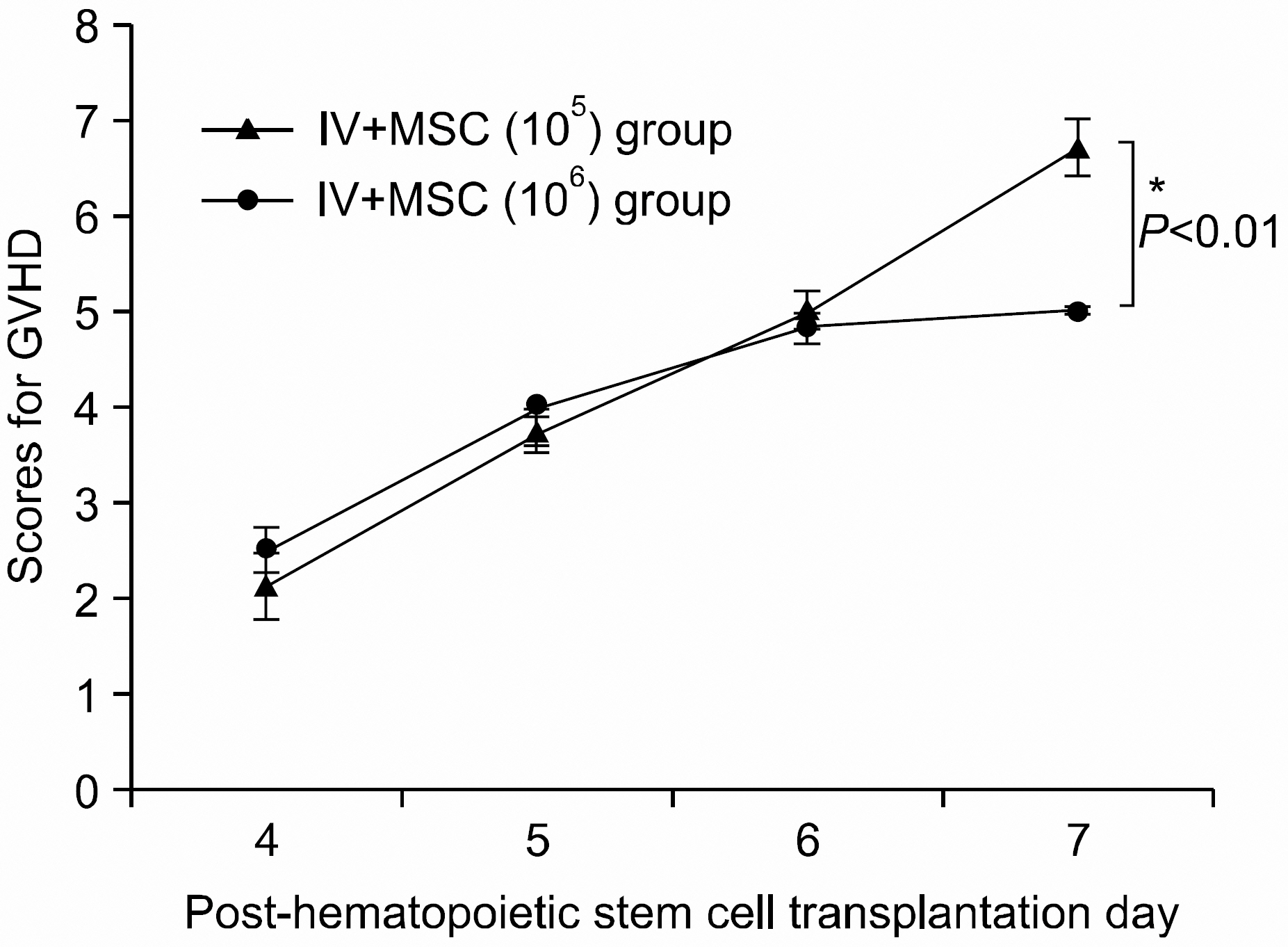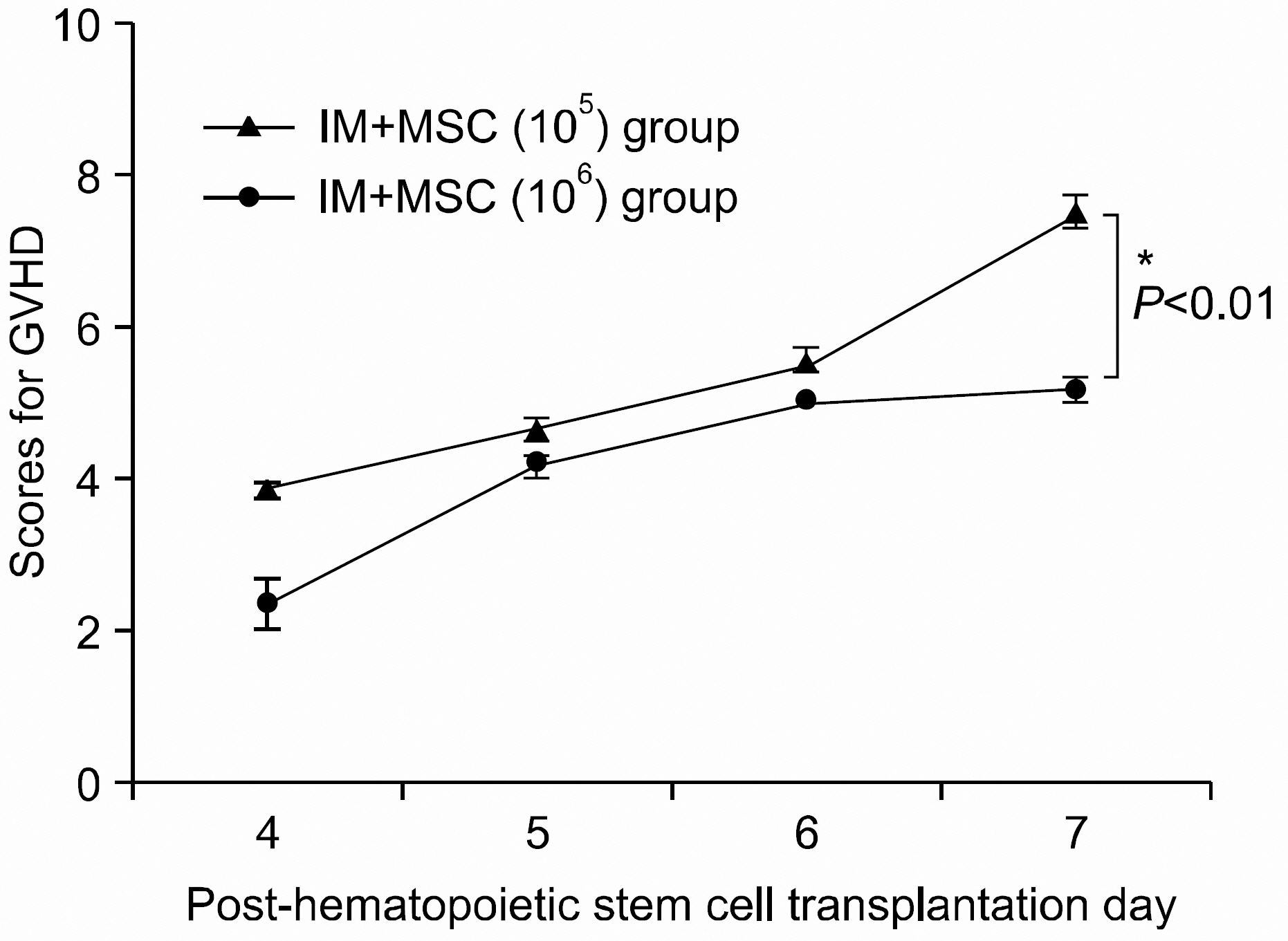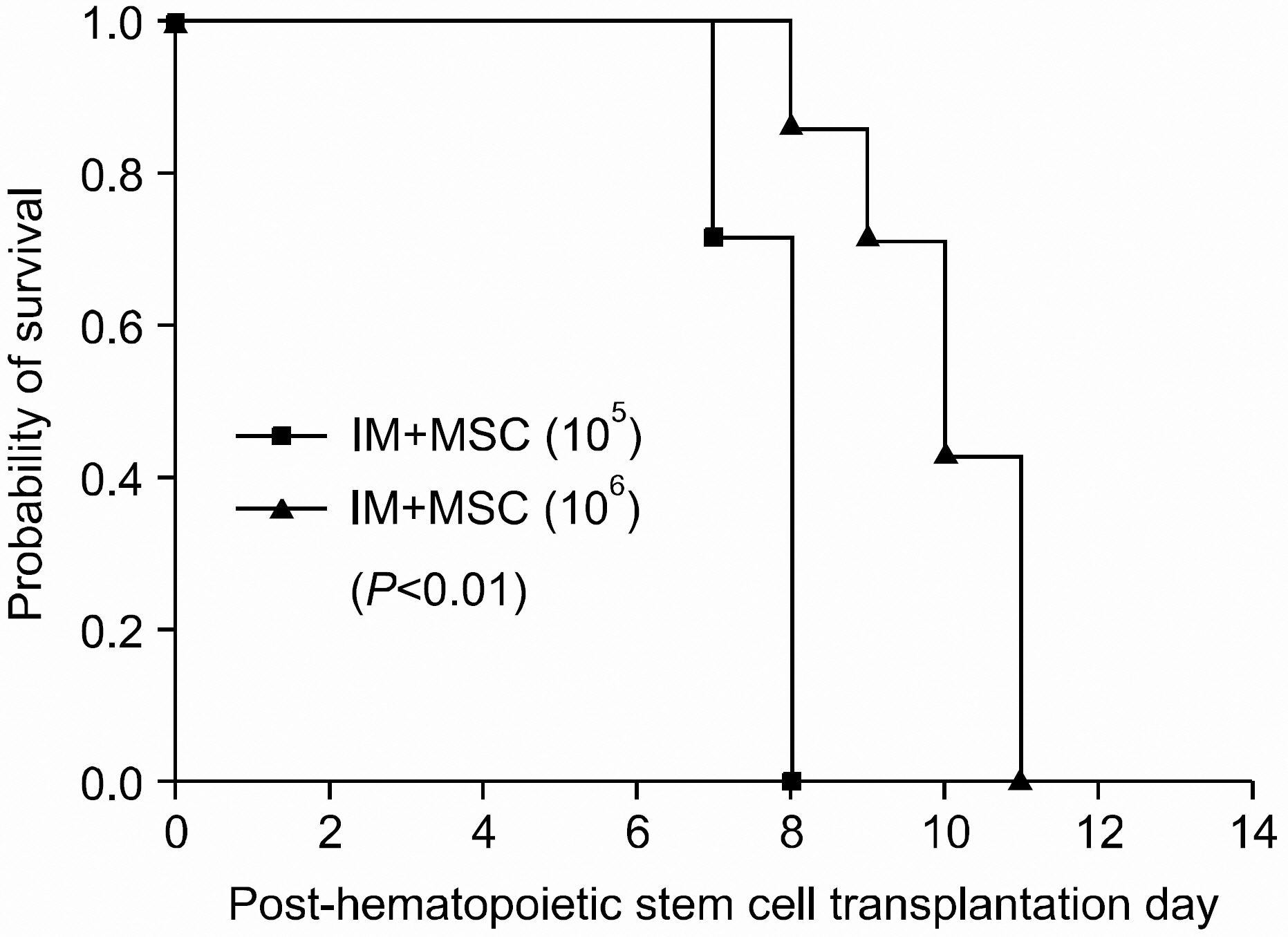Korean J Hematol.
2006 Dec;41(4):250-258. 10.5045/kjh.2006.41.4.250.
Survival and Graft versus Host Disease in Murine MHC Mismatched Hematopoietic Stem Cell Transplantation with Co-injection of Mesenchymal Stem Cells
- Affiliations
-
- 1Department of Pediatrics, College of Medicine, The Catholic University of Korea, Seoul, Korea. kimhk@catholic.ac.kr
- 2Department of Internal Medicine, College of Medicine, The Catholic University of Korea, Seoul, Korea.
- KMID: 2305211
- DOI: http://doi.org/10.5045/kjh.2006.41.4.250
Abstract
-
BACKGROUND: Intravenous injection of mesenchymal and hematopoietic stem cells (MSCs, HSCs) has the disadvantages of low delivery rate to bone marrow and sequestration of cells in the lung and liver. This study was designed to determine whether there is a relationship between the administration route and dosage of stem cells and GVHD and survival.
METHODS
MSCs were retrieved from five subcultured C3H/10T1/2, cell lines from C3H/He mice. HSCs were transplanted by injecting 1 x 10(7) of bone marrow mononuclear cells and 5 x 10(6) of spleen cells from six to eight week old female C3H/He mice into six week old irradiated female BALB/c mice. The groups were divided into intravenous injection (IV) and intra-marrow (IM) injection groups. IV and IM+MSC groups consisted of mice transplanted with the same bone marrow mononuclear cells and SP, IV and IM groups, with the additional co-injection of 1 x 10(6) MSCs.
RESULTS
Evaluation of all mice, in both groups, showed no difference in GVHD and survival. However, high dose injection with 1 x 10(6) MSCs led to a decreased incidence of GVHD (P<0.05) and improved survival (P<0.01) in both groups.
CONCLUSION
The results of this study showed that the positive effects of MSC on GVHD and survival were primarily dependent on the number of injected cells.
MeSH Terms
Figure
Reference
-
1). Torok-Storb B., Holmberg L. Role of marrow micro-environment in engraftment and maintenance of allogeneic hematopoietic stem cells. Bone Marrow Transplant. 1994. 14:S71–3.2). Fouillard L., Bensidhoum M., Bories D, et al. Engraftment of allogeneic mesenchymal stem cells in the bone marrow of a patient with severe idiopathic aplastic anemia improves stroma. Leukemia. 2003. 17:474–6.
Article3). Koc ON., Gerson SN., Cooper BW, et al. Rapid hematopoietic recovery after coinfusion of autologous-blood stem cells and culture-expanded marrow mesenchymal stem cells in advanced breast cancer patients receiving high-dose chemotherapy. J Clin Oncol. 2000. 18:307–16.4). Noort WA., Kruisselbrink AB., in't Anker PS, et al. Mesenchymal stem cells promote engraftment of human umbilical cord blood-derived CD34(+) cells in NOD/SCID mice. Exp Hematol. 2002. 30:870–8.
Article5). Tse WT., Pendleton JD., Beyer WM., Egalka MC., Guinan EC. Suppression of allogeneic T-cell proliferation by human marrow stromal cells: implications in transplantation. Transplantation. 2003. 75:389–97.
Article6). Gao J., Dennis JE., Muzic RF., Lundberg M., Caplan AI. The dynamic in vivo distribution of bone marrow-derived mesenchymal stem cells after infusion. Cells Tissues Organs. 2001. 169:12–20.
Article7). Zhang Y., Yasumizu R., Sugiura K, et al. Fate of allogeneic or syngeneic cells in intravenous or portal vein injection: possible explanation for the mechanism of tolerance induction by portal vein injection. Eur J Immunol. 1994. 24:1558–65.
Article8). Rombouts WJ., Ploemacher RE. Primary murine MSC show highly efficient homing to the bone marrow but lose homing ability following culture. Leukemia. 2003. 17:160–70.
Article9). Kim JH., Auerbach JM., Rodriguez-Gomez JA, et al. Dopamine neurons derived from embryonic stem cells function in an animal model of Parkinson's disease. Nature. 2002. 418:50–6.
Article10). Stamm C., Westphal B., Kleine HD, et al. Autologous bone-marrow stem-cell transplantation for myocardial regeneration. Lancet. 2003. 361:45–6.
Article11). Ikehara S. A novel strategy for allogeneic stem cell transplantation: perfusion method plus intra-bone marrow injection of stem cells. Exp Hematol. 2003. 31:1142–6.
Article12). Mazurier F., Doedens M., Gan OI., Dick JE. Rapid myeloerythroid repopulation after intrafemoral transplantation of NOD-SCID mice reveals a new class of human stem cells. Nat Med. 2003. 9:959–63.
Article13). Chung NG., Jeong DC., Park SJ, et al. Cotransplan-tation of marrow stromal cells may prevent lethal graft-versus-host disease in major histocompatibility complex mismatched murine hematopoietic stem cell transplantation. Int J Hematol. 2004. 80:370–6.
Article14). Jeong DC., Han CW., Jin JY, et al. Effectiveness of rotor off fraction in allogeneic murine bone marrow transplantation with complete disparity of major histocompatibility. Exp Hamatol. 1999. 27:1219–25.
Article15). Cooke KR., Kobzik L., Martin TR, et al. An experi mental model of idiopathic pneumonia syndrome after bone marrow transplantation: I. The roles of minor H antigens and endotoxin. Blood. 1996. 88:3230–9.16). Fridenshtein AIa. Stromal bone marrow cells and the hematopoietic microenvironment. Arkh Patol. 1982. 44:3–11.17). Javazon EH., Beggs KJ., Flake AW. Mesenchymal stem cells: paradoxes of passaging. Exp Hematol. 2004. 32:414–25.
Article18). Krampera M., Glennie S., Dyson J, et al. Bone marrow mesenchymal stem cells inhibit the response of naive and memory antigen-specific T cells to their cognate peptide. Blood. 2003. 101:3722–9.
Article19). Bartholomew A., Sturgeon C., Siatskas M, et al. Mesenchymal stem cells suppress lymphocyte proliferation in vitro and prolong skin graft survival in vivo. Exp Hematol. 2002. 30:42–8.
Article20). Di Nicola M., Carlo-Stella C., Magni M, et al. Human bone marrow stromal cells suppress T-lymphocyte proliferation induced by cellular or nonspecific mitogenic stimuli. Blood. 2002. 99:3838–43.
Article21). Meisel R., Zibert A., Laryea M., Gobel U., Daubener W., Dilloo D. Human bone marrow stromal cells inhibit allogeneic T-cell responses by indoleamine 2,3-dioxygenase-mediated tryptophan degradation. Blood. 2004. 103:4619–21.
Article22). Goker H., Haznedaroglu IC., Chao NJ. Acute graft-vs-host disease: pathobiology and management. Exp Hematol. 2001. 29:259–77.
Article23). Ferrara JL., Cooke KR., Pan L., Krenger W. The im-munopathophysiology of acute graft-versus-host-disease. Stem Cells. 1996. 14:473–89.
Article24). Wysocki CA., Panoskaltsis-Mortari A., Blazar BR., Serody JS. Leukocyte migration and graft-versus-host disease. Blood. 2005. 105:4191–9.
Article25). Le Blanc K., Rasmusson I., Sundberg B, et al. Treatment of severe acute graft-versus-host disease with third party haploidentical mesenchymal stem cells. Lancet. 2004. 363:1439–41.
Article
- Full Text Links
- Actions
-
Cited
- CITED
-
- Close
- Share
- Similar articles
-
- Enhancement of Graft-versus-leukemia Effects by Mesenchymal Stem Cells in Mixed Chimerisim after a Murine Non-myeloablative Hematopoietic Stem Cell Transplantation
- A case of pneumomediastinum combined with chronic graft-versus-host disease following allogeneic hematopoietic stem cell transplantation
- The Strategies for the Prevention of Chronic GVHD in Hematopoietic Stem Cell Transplantation
- Cell Therapy in Hematopoietic Stem Cell Transplantation
- Hematopoietic stem cell transplantation: overview for general pediatrician








